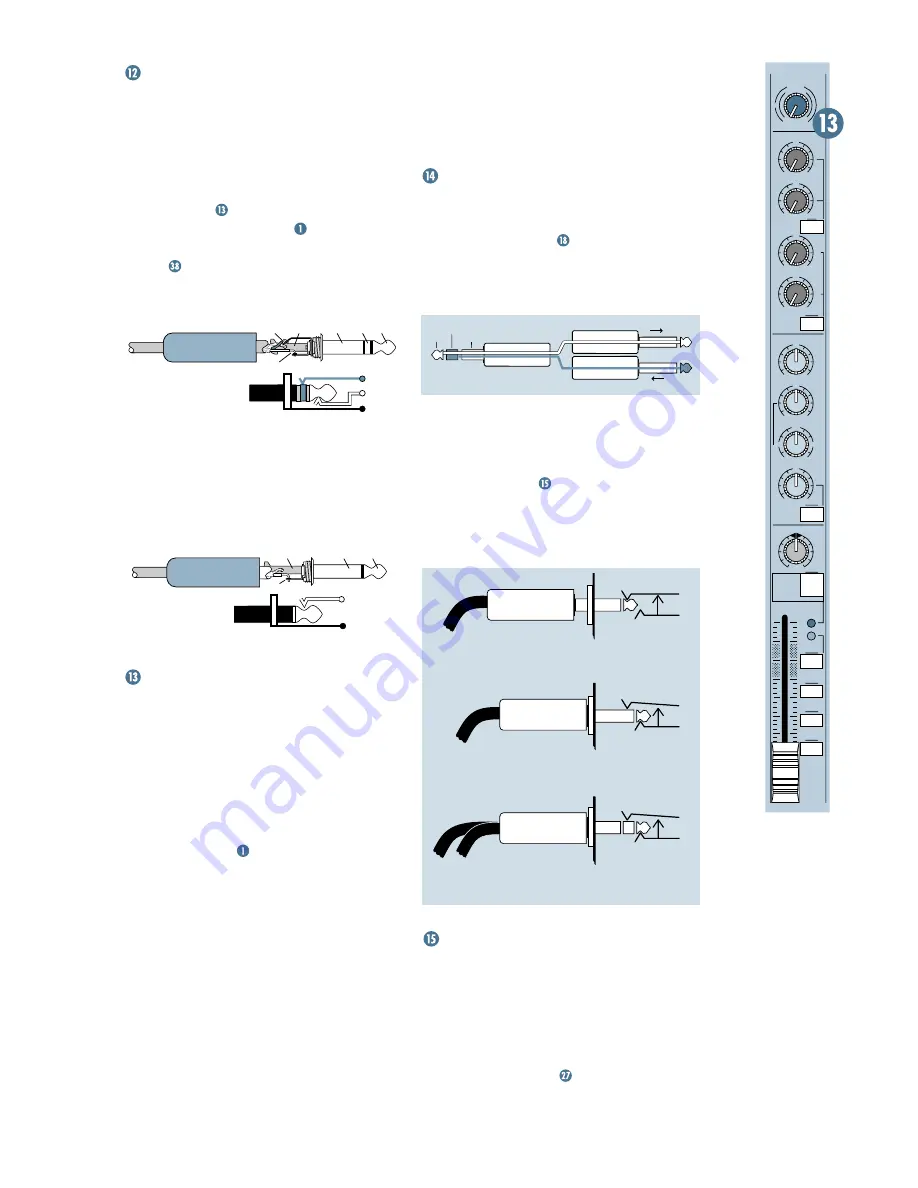
11
LINE INPUTS
These
1
/
4
" jacks share circuitry (but not
phantom power) with the mic preamps. You
can use these inputs for virtually any signal
you’ll come across, from instrument levels as
low as –40dB to operating levels of –10dBV to
+4dBu, as there is 40dB of gain available via
the
TRIM
knob
. Always be sure to perform
the
Level-Setting Procedure
.
To learn how signals are routed from these
inputs: . To connect balanced lines to these
inputs, use a
1
/
4
" tip-ring-sleeve (TRS) plug,
the type found on some stereo headphones:
Tip = positive (+ or hot)
Ring = negative (– or cold)
Sleeve = shield or ground
To connect unbalanced lines to these in-
puts, use a
1
/
4
" mono (TS) phone plug or
standard instrument cable:
Tip = signal (+)
Sleeve = ground
TRIM
Yes it’s true, these controls are not located
in the patchbay section at all. They’re found
along the top row of knobs in the channel strip
section. But their purpose is so closely linked
with the
MIC
and
LINE
input jacks that we
couldn’t bear to separate them. Here’s why:
Every time you plug something into a
MIC
or
LINE
input jack, you should perform the
Level-
Setting Procedure
, and that procedure is
basically “how to use the
TRIM
knob.”
TRIM
adjusts the input sensitivity of the
MIC
and
LINE
inputs. This allows signals from
the outside world to be adjusted to optimal
internal operating levels.
Through the XLR jack (
MIC
), there will be
10dB of gain with the knob fully down, ramp-
ing to 60dB of gain fully up.
Through the
1
/
4
" input (
LINE
), there is 10dB
of attenuation fully down and 40dB of gain fully
up, with a “
U
” (unity gain) mark at 9:00.
This 10dB of attenuation can be very handy
when you are inserting a signal that is very hot,
or you want to add a lot of EQ gain, or both.
Without this “virtual pad,” a scenario like that
might lead to channel clipping.
INSERT
These
1
/
4
" jacks are for connecting serial
effects processors such as compressors, equaliz-
ers, de-essers, or filters . The
INSERT
point is
after the
TRIM
control, but before the channel’s
EQ
,
LOW CUT,
fader and
MUTE
controls. Insert
cables must be wired thusly:
“tip”
This plug connects to one of the
mixer’s Channel Insert jacks.
“ring”
tip
ring
sleeve
SEND to processor
RETURN from processor
(TRS plug)
Tip = send (output to effects device)
Ring = return (input from effects device)
Sleeve = common ground
Even though channels 1–8 already have
DIRECT OUT
jacks
,
INSERT
jacks can also
be used as channel direct outputs; post-
TRIM
,
pre-
LOW CUT
, and pre-
EQ
. Here’s three ways
you can use the
INSERT
jacks:
Direct out with no signal interruption to master.
Insert only to first “click.”
Channel Insert jack
Channel Insert jack
Channel Insert jack
Direct out with signal interruption to master.
Insert all the way in to the second “click.”
For use as an effects loop.
(TIP = SEND to effect, RING = RETURN from effect.)
MONO PLUG
MONO PLUG
STEREO
PLUG
DIRECT OUT
Found only on channels 1–8, these
1
/
4
" jacks
deliver the signal from the very end of the
channel path; post-
TRIM
, post-
EQ
, post-
LOW
CUT
, post-fader and post-
MUTE
. They are the
key player in “split monitoring,” making the
CR1604-VLZ perfect for an 8-track studio.
To
wire your own cables:
.
PAN
AUX
3
1
2
EQ
5
4
6
5/6
SHIFT
PRE
TRIM
1
SOLO
L - R
3–4
1–2
OL
-20
U
O
O
+15
U
O
O
+15
U
O
O
+15
U
+15
-15
U
+15
-15
800
2k
200
8k
U
+15
-15
12k
HI
MID
80Hz
LOW CUT
75 Hz
18dB/OCT
LOW
100
U
O
O
+15
1
MUTE
MI
C GAIN
10
U
60
+10dB
-40dB
-10dBV
L
R
O
O
SLEEVE
TIP
TIP
SLEEVE
TIP
SLEEVE
SLEEVE
TIP
SLEEVE
TIP
RING
RING
TIP
SLEEVE
RING


























